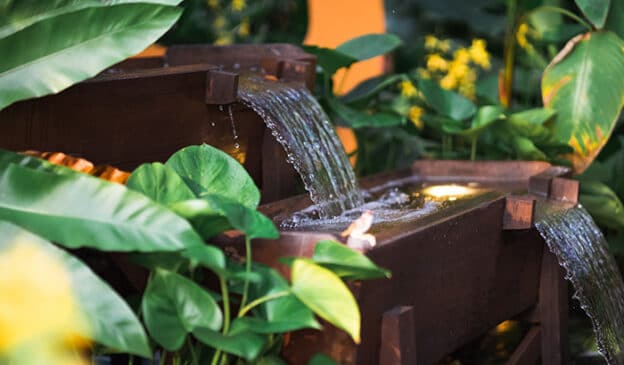Proper water drainage is critical to a happy and healthy landscape, but how can you tell if your yard has sufficient drainage? A lawn that doesn’t drain well can lead to problems with your home’s foundation, bug infestations, and severe damage to your landscape.
Fortunately, it’s not too hard to identify a problem since there are several telltale signs of drainage issues. The first thing you’ll notice is wet, swampy grass. Some areas might appear dry, while others are a muddy mess.
Standing water in any area of your landscape is another sign of a drainage issue. So, if you’re seeing puddles or extra-muddy areas in your yard, there’s lots of room for improvement.
Here’s a look at everything you need to know about drainage in your yard, including what to look for when it comes to proper drainage, common causes of drainage problems, and how to improve drainage in your landscape.
What Does Proper Water Drainage Look Like?
Even though problems with drainage may be easy to identify, sometimes you don’t know you have a problem until it’s too late. So what exactly does proper water drainage look like? Let’s dive in.
- Gutters and downspouts – Most of the water that makes its way into your landscape comes from the sky, so having adequate gutters and downspouts is essential to proper drainage for your home and yard.
Ensure they’re in good condition and attached properly to your roof. The downspouts should direct water away from your home’s foundation. If your downspouts aren’t long enough, a downspout extender might be necessary.
- In-Ground drainage system – Take a walk around your home, and check for any in-ground drains. If you have a drainage system installed, these should be located at low points in your landscaping. They are often installed in front of basement doors and underneath the gravel in window wells.
If your home doesn’t have an in-ground drainage system, you should contact a landscape professional to get one installed right away.
- Proper grading – Grading is one of the most important parts of your yard’s drainage. Proper grading means that your landscape slopes away from your foundation by at least half an inch per foot for at least ten feet.
This will help water flow away from your home, and as long as the grading continues throughout your yard, it should prevent water from pooling in your grass.
Common Causes of Water Drainage Problems
Many problems can arise, even if your yard starts with excellent drainage. So when your yard is no longer draining water properly, one of these common causes of drainage problems might be to blame.
- Impacted soil – One of the most common problems that lead to drainage issues is impacted soil. This occurs when your soil has been compacted so much that water can’t seep through the cracks.
Impacted soil is frequently a result of construction work like installing a pool or putting green. That’s because the heavy equipment driving over your grass presses the ground down and compacts it together. Clay soil becomes especially problematic when it gets impacted because it holds on to so much moisture.
- Poor slope – Your yard may have been perfectly graded once upon a time, but after years of use and plenty of runoff traveling down the slope, it’s probably not sloping quite enough anymore. It’s also possible that the general slope is sufficient, but there are divots and low spots that collect water, leading to drainage issues.
- Erosion – Another common problem occurs when the water from a downspout erodes the soil in the landscaping underneath the downspout. This can damage your landscape and lead to extra water collecting and gathering underneath the eroded soil.
How To Improve Drainage in Your Landscape
Once you’ve recognized you have a drainage issue, there are several things you can do to help correct it. Watering less will help temporarily, but it won’t treat the cause of the problem. You’ll still deal with drainage issues when heavy rains come your way.
These steps for improving drainage can also help prevent an issue from arising in the first place. You can do some of these things on your own, but it’s best to call a professional landscaping company to help with drainage problems. They have the right tools and knowledge to ensure things are done properly so you can avoid further damage to your home and landscape.
- Aerate your lawn. Aerating is an extremely effective way to prevent and correct impacted soil. It opens up room in your soil by pulling out sections of the affected ground.
It’s best to rake a thin layer of compost over the ground after aerating to deliver much-needed nutrients deep into the soil. You can rent an aerator from your local home improvement store, but it can be cumbersome. A landscaper can tackle the task quickly and easily, and it’s well worth the small fee to have it done by a professional.
- Install a water drainage system. Several types of drainage systems can help improve your yard’s ability to drain water. So if you have one that’s not working for you, a new system might be the best option.
Possible options include French drains and sump pumps, along with several others. A professional landscaper can evaluate your yard and recommend the best system for your topography.
LaytonScape Is Here
Getting adequate water drainage for your yard is essential to a thriving landscape. That’s why the landscaping experts at LaytonScape are here to help!
Our knowledgeable and experienced team has the tools and skills to tackle your landscaping project today. We are a full-service landscape provider and offer sprinkler system installation, garden design, water features, hardscape installation, and more!We provide landscaping services to clients across northern Utah, including Ogden, Park City, Layton, Kaysville, Farmington, Bountiful, Clearfield, Morgan, and Huntsville. Contact LaytonScape today to get started on your landscaping project!



